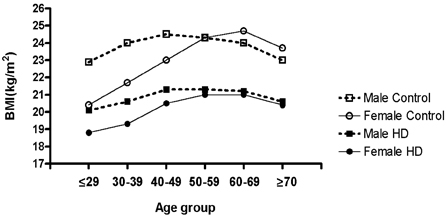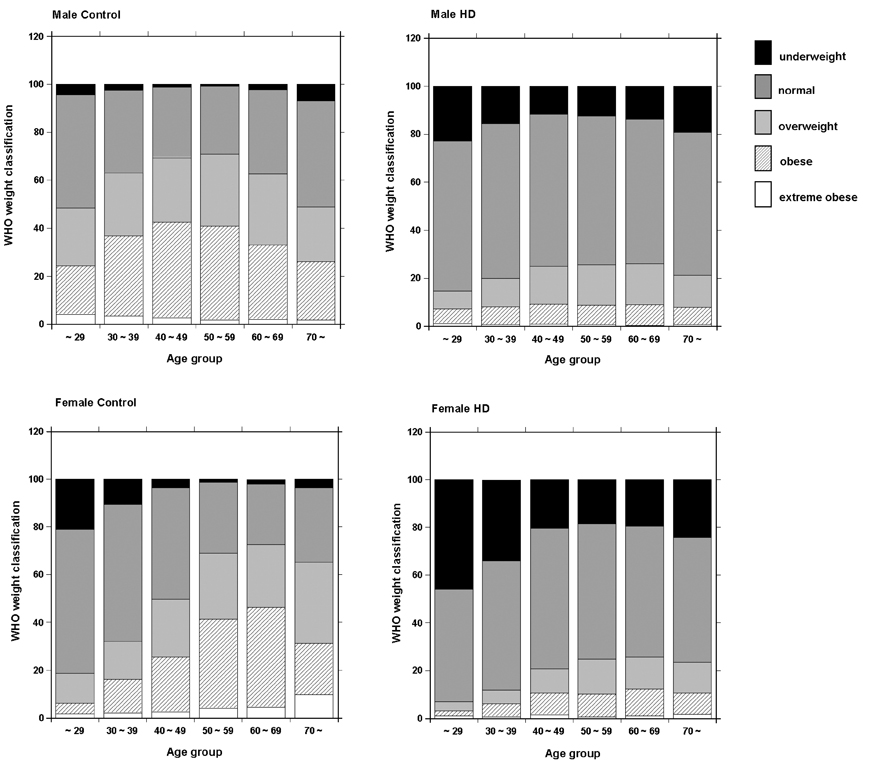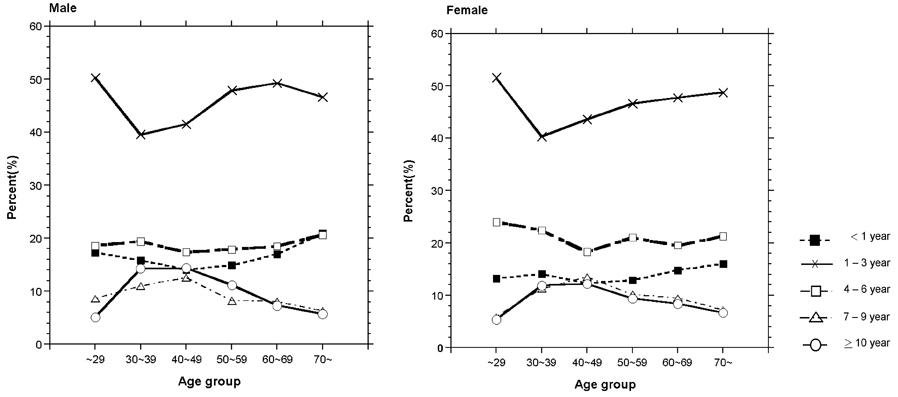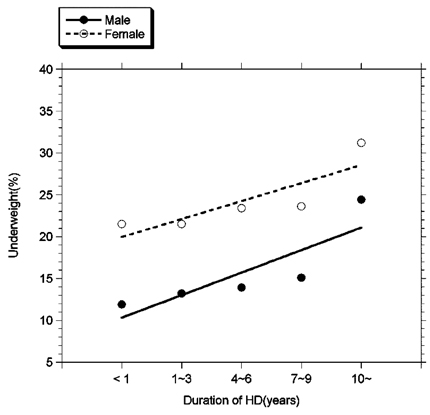Yonsei Med J.
2005 Oct;46(5):658-666. 10.3349/ymj.2005.46.5.658.
Comparison of Anthropometric Data between End-stage Renal Disease Patients Undergoing Hemodialysis and Healthy Adults in Korea
- Affiliations
-
- 1Division of Nephrology and Hypertension, Department of Internal Medicine, Kidney Disease Research Group, Inha University College of Medicine, Inchon, Korea. nhkimj@inha.ac.kr
- KMID: 2158146
- DOI: http://doi.org/10.3349/ymj.2005.46.5.658
Abstract
- Protein-calorie malnutrition is prevalent in hemodialysis (HD) patients. The prevalence of obesity in healthy Korean adults has increased rapidly during the last 10 years. However, there are few large scale data collections available about the current weight status of Korean HD patients. The weight statuses of 10, 304 HD patients (data from the Insan Memorial Dialysis Registry 2002, Korean Society of Nephrology) were compared to those of 12, 436 control subjects (age > 18) by using body mass index (BMI). Weight status was assessed by WHO classification for Asian-Pacific region [underweight (UW) : < 18.5; normal weight (NW) : 18.5-22.9; overweight (OW) : 23-24.9; obese (OB) : 25-29.9; and extremely obese (EOB) : > 30 kg/m2] in both the control and HD patients. HD patients had significantly lower body weight and BMI than the controls in all age groups and in both sexes. For the male controls, the proportions of OW and OB showed a reversed U-shape, peaking at the 5th and 6th decades. of the numbers of those classified as NW and UW were relatively small. For the female controls, the proportions of OW and OB progressively increased with age. On the contrary, in HD patients, the proportions of NW and UW were large, up to more than 70%, and those of OW and OB were small in both sexes. In each age group, UW was seen significantly more in the HD group than in the control group. The 6th decade age group showed the highest prevalence ratio for UW in the HD group for both sexes, compared to the controls (Male: 17.33, Female: 17.68). The percentages of UW were related to HD duration and age in both sexes. In conclusion, Korean HD patients seem to have small proportions of OW and OB, compared to the general population, and protein-calorie malnutrition may still be an important nutritional condition.
MeSH Terms
Figure
Cited by 1 articles
-
The Mildly Elevated Serum Bilirubin Level is Negatively Associated with the Incidence of End Stage Renal Disease in Patients with IgA Nephropathy
Ho Jun Chin, Hyun Jin Cho, Tae Woo Lee, Ki Young Na, Kook Hwan Oh, Kwon Wook Joo, Hyung Jin Yoon, Yon-Su Kim, Curie Ahn, Jin Suk Han, Suhnggwon Kim, En Sil Jeon, Dong Chan Jin, Yong-Lim Kim, Sun-Hee Park, Chan-Duck Kim, Young Rim Song, Seong Gyun Kim, Yoon Goo Kim, Jung Eun Lee, Yoon Kyu Oh, Chun Soo Lim, Sang Koo Lee, Dong-Wan Chae, Won Yong Cho, Hyoung Kyu Kim, Sang-Kyung Jo,
J Korean Med Sci. 2009;24(Suppl 1):S22-S29. doi: 10.3346/jkms.2009.24.S1.S22.
Reference
-
1. Centers for Disease Control and Prevention: Prevalence of overweight and obesity among adults with diagnosed diabetes: United States. 1999-2002. www.cdc.gov/nchs/products/pubs/pubd/hestats/obese/obse99.htm.2. Stunkard AJ, Wadden TA. Obesity: theory and therapy, Second Edition. 1993. New York: Raven Press.3. Marckmann P. Nutritional status of patients on hemodialysis and peritoneal dialysis. Clin Nephrol. 1988. 29:75–78.4. Enia G, Sicuso C, Alati G, Zoccali C. Subjective global assessment of nutrition in dialysis patients. Nephrol Dial Transplant. 1993. 8:1094–1098.5. Cianciaruso B, Brunori G, Kopple JD, Traverso G, Panarello G, Enia G, et al. Cross-sectional comparison of malnutrition in continuous ambulatory peritoneal dialysis and hemodialysis patients. Am J Kidney Dis. 1995. 26:475–486.6. Leavey SF, Strawderman RL, Jones CA, Port FK, Held PJ. Simple nutritional indicators as independent predictors of mortality in hemodialysis patients. Am J Kidney Dis. 1998. 31:997–1006.7. Qureshi AR, Alvestrand A, Danielsson A, Divino-Filho JC, Gutierrez A, Lindholm B, et al. Factors predicting malnutrition in hemodialysis patients: a cross-sectional study. Kidney Int. 1998. 53:773–782.8. Chumlea WC, Dwyer J, Bergen C, Burkart J, Paranandi L, Frydrych A, et al. Hemodialysis Study Group. Nutritional status assessed from anthropometric measures in the HEMO study. J Ren Nutr. 2003. 13:31–38.9. Dumler F, Kilates C. Body composition analysis by bioelectrical impedance in chronic maintenance dialysis patients: comparisons to the national health and nutrition examination survey III. J Ren Nutr. 2003. 13:166–172.10. Pupim LB, Ikizler TA. Uremic malnutrition: new insights into an old problem. Semin Dial. 2003. 16:224–232.11. Pupim LB, Caglar K, Hakim RM, Shyr Y, Ikizler TA. Uremic malnutrition is a predictor of death independent of inflammatory status. Kidney Int. 2004. 66:2054–2060.12. Cooper BA, Penne EL, Bartlett LH, Pollock CA. Protein malnutrition and hypoalbuminemia as predictors of vascular events and mortality in ESRD. Am J Kidney Dis. 2004. 43:61–66.13. Leavey SF, McCullough K, Hecking E, Goodkin D, Port FK, Young EW. Body mass index and mortality in 'healthier' as compared with 'sicker' haemodialysis patients: results from the Dialysis Outcomes and Practice Patterns Study(DOPPS). Nephrol Dial Transplant. 2001. 16:2386–2394.14. Kopple JD, Zhu X, Lew NL, Lowrie EG. Body weightfor-height relationship predict mortality in maintenance hemodialysis patients. Kidney Int. 1999. 56:1136–1148.15. Ministry of Health & Welfare. Report on 2001 national health and nutritional survey: Nutrition survey(1). 2002. Korea Health Industry Department.16. Kim YK, Choi KH, Kang SW, Lee HW, Lee SW, Lee HY, et al. Nutritional assessment of chronic dialysis patients. Korean J Nephrol. 1990. 9:58–66.17. Han SY, Jo SK, Yoon JW, Shin JH, Lee SY, Kang YS, et al. Nutritional parameters and inflammatory mediators in maintenance hemodialysis patients. Korean J Nephrol. 2000. 19:303–311.18. Kim JH, Kim SR. Subjective global assessment of nutrition in maintenance hemodialysis patients. Korean J Nephrol. 2001. 20:270–276.19. Lee HT, Cho S, Lee SH, Kim SR, Kim YH, Seo HJ. Influence of routine calorie and protein intake on nutritional status in stable chronic hemodialysis patients: a 18 months follow-up study. Korean J Nephrol. 2002. 21:129–136.20. ESRD registry committee, Korean Society of Nephrology. Renal replacement therapy in Korea-Insan memorial dialysis registry 2002. Korean J Nephrol Suppl. 2003. 22:S353–S377.21. Regional Office for the Western Pacific (WPRO), World Health Organization. International Association for the Study of Obesity. International Obesity Task Force. The Asia-Pacific perspective: redefining obesity and its treatment. 2000. Health Communications Australia.22. Kang JH, Kim NS. Secular trend of obesity prevalence in Korea. J Korean Soc Obes. 2002. 11:329–336.23. Lorenzo V, Martin M, Rufino M, Sanchez E, Jimenez A, Hernandez D, et al. High prevalence of overweight in a stable Spanish hemodialysis population: a cross sectional study. J Ren Nutr. 2003. 13:52–59.24. Friedman AN, Miskulin DC, Rosenberg IH, Levey AS. Demographics and trends in overweight and obesity in patients at time of kidney transplantation. Am J Kidney Dis. 2003. 41:480–487.25. ESRD registry committee, Korean Society of Nephrology. Renal replacement therapy in Korea-Insan memorial dialysis registry 2003. Korean J Nephrol Suppl. 2004. 23:Suppl 2. S381–S404.26. Chertow GM, Johansen KL, Lew N, Lazarus JM, Lowrie EG. Vintage, nutritional status, and survival in hemodialysis patients. Kidney Int. 2000. 57:1176–1181.27. Chazot C, Laurent G, Charra B, Blanc C, VoVan C, Jean G, et al. Malnutrition in long-term haemodialysis survivors. Nephrol Dial Transplant. 2001. 16:61–69.28. Kim BH, Do JY, Cho IH, Yoon KW. A study on the characteristics of the hemodialysis patients with poor nutritional status in CRF. Korean J Nephrol. 1995. 14:107–114.29. Choi SR, Lee SC, Kim BS, Yoon SY, Park HC, Kang SW, et al. Comparative study of renal replacement therapy in Korean diabetic end-stage renal disease patients: a single center study. Yonsei Med J. 2003. 44:454–462.30. Burrowes JD, Cockram DB, Dwyer JT, Larive B, Paranandi L, Bergen C, et al. Cross-sectional relationship between dietary protein and energy intake, nutritional status, functional status, and comorbidity in older versus younger hemodialysis patients. J Ren Nutr. 2002. 12:87–95.31. Wolfson M. Nutrition in elderly dialysis patients. Semin Dial. 2002. 15:113–115.32. K/DOQI clinical practice guidelines for nutrition in chronic renal failure. DOQI clinical practice guidelines for nutrition in chronic renal failure. Am J Kidney Dis Suppl. 2000. 5:S17–s104.33. World Health Organization. Report of a WHO expert committee (WHO Technical Report Series, no. 854). Physical status. the use and interpretation of anthropometry. 1995. Geneva:34. World Health Organization. International Obesity Task Force. Report of the WHO consultation on obesity. Managing the global epidemic of obesity. 1997. Geneva:35. Port FK, Ashby VB, Dhingra RK, Roys EC, Wolfe RA. Dialysis dose and body mass index are strongly associated with survival in hemodialysis patients. J Am Soc Nephrol. 2002. 13:1061–1066.
- Full Text Links
- Actions
-
Cited
- CITED
-
- Close
- Share
- Similar articles
-
- Phenomenology on the Hemodialysis Experience of Patients with End-Stage Renal Disease
- A Studyof Dermal Mast Cells Number in End Stage of Renal Failure
- Acquired Cystic Kidney Disease in Patients Undergoing Long-term Hemodialysis Treatment
- Valacyclovir-Induced Neurotoxicity in a Maintenance Hemodialysis Patient
- Effect of Hemodialysis on Taste Acuity in Patient with End-Stage Renal Disease





